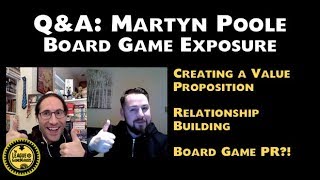
It’s Pictionary Night. Aunt Karen and company are on the brink of capturing an unlikely victory… After all, her utter absence of two artistic cells to rub together is overshadowed only by Uncle Randy’s atrocious inability to guess under pressure. But for some reason–maybe it’s something in the Swedish meatballs–he and Aunt Karen are actually on the same wavelength! And as she draws lines of (supposedly) fur on some (almost) four-legged (I think) creature (let’s go with that), your team’s seven-month winning streak is being threatened.
You are the official timer (And what an honor! Not everyone gets to use your father’s Boggle sand timer from when he was in college). If Aunt Karen’s team doesn’t stumble on the right answer before the last grain of sand hits the bottom, the Tim-Horton’s-mug-turned-Pictionary-trophy will receive its eighth tally mark and maintain its esteemed position atop your sock drawer.
DESPERATE TIMES CALL FOR DESPERATE MEASURES. YOU SHAKE THE SAND TIMER VIGOROUSLY…
Does this work to empty the timer faster? If so, what’s the best method? Might it actually serve to slow the timer? Or do all methods of shaking the timer have no effect on when it runs out?
I set out to uncover the shaky truth behind the sand timer.
DISCLAIMER: ANY RESEMBLANCE TO REAL SCIENCE IN THIS WORK IS PURELY COINCIDENTAL.
—
I retrieved my standard gaming sand timer from my prototyping kit. The first step in my investigation was to establish a control by averaging six timed runs (that is, three runs in each direction, “A” and “B”)

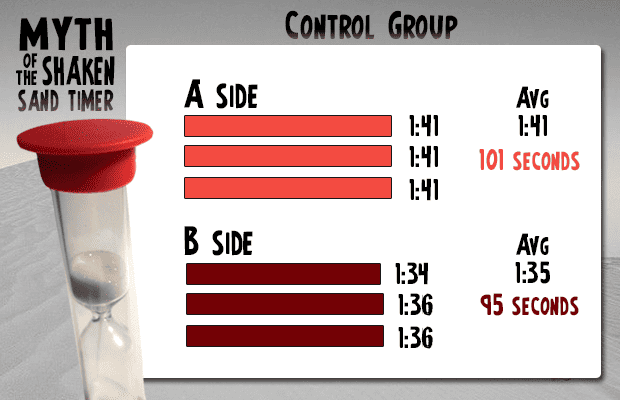
Apparently my timer runs longer in one direction than it does in the other. I now apologize to half the people with whom I’ve played games with this timer, for robbing them of about 6 seconds.
Regardless, the control is still usable. I labeled the timer itself, one side “A” (when face up, yields the “A” times), and one side “B” (yielding the “B” times).
Now to study the effects of various sand timer shaking theories. I believe there are three common methods of attempting to alter the sand.
- Top-tapping (suspended and grounded)
- Flicking (top and bottom)
- Shaking (horizontal and vertical)

For this test, the sand timer was held in one hand while a finger from the other hand repeatedly tapped the top of the timer.
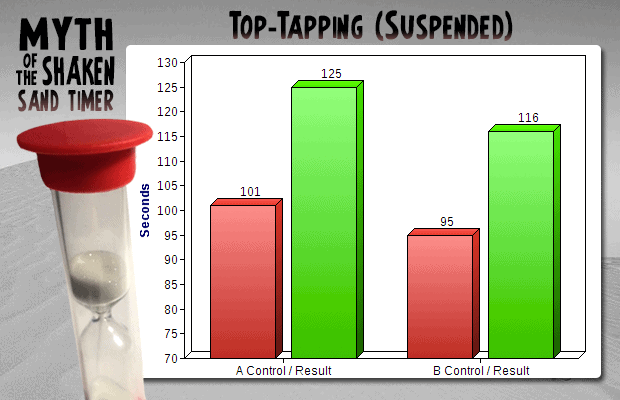
A 2:05 (125 seconds) / +24 seconds
B 1:56 (116 seconds) / +20 seconds
And, because I’m a bored non-scientist, I think I’ll call one run good enough. It seems that tapping only lengthens the time. I wonder, though, if that’s because the sand jumps up a bit when recoiling from the tap. If the timer were grounded on a flat surface, and then tapped on top, would it eliminate the recoil and the resulting delay?
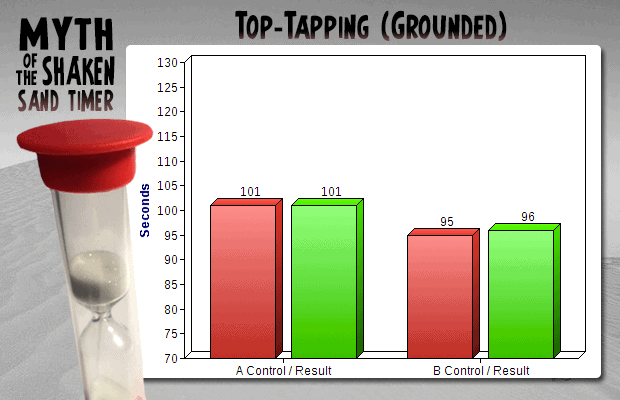
A 1:41 (101 seconds) / +0 seconds
B 1:36 (96 seconds) / +1 second
The answer to my previous question is yes – it appears that keeping the timer on the table while tapping does eliminate the apparent recoil effect. Ultimately, though, grounded top-tapping does nothing but tire your tapping finger. I’m okay with that. I’m starting to wish I had a shorter sand timer.
Next, I want to increase the physical violence to the sand timer. I’ll start by repeatedly flicking the timer’s top compartment in an attempt to persuade the sand to fall faster.

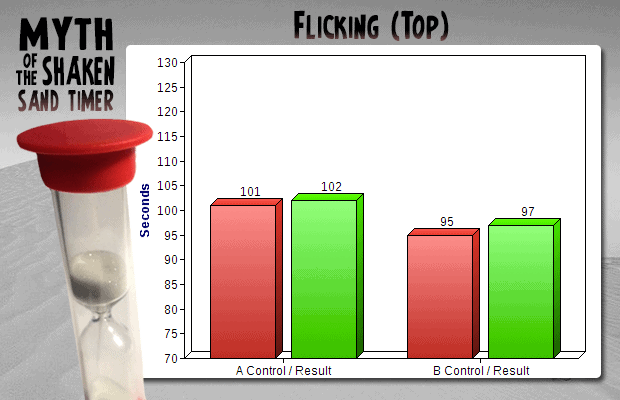
A 1:42 (102 seconds) / +1 second
B 1:37 (97 seconds) / +2 seconds
One bruised fingernail later, the results are in! It seems that flicking the top compartment of the timer only slightly slows its progress. But it is slowed nonetheless. Maybe, just maybe, flicking the bottom compartment will yield different results.
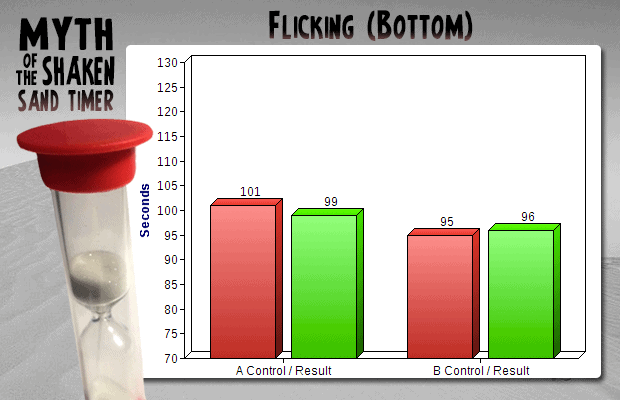
A 1:39 (99 seconds) / -2 seconds
B 1:36 (96 seconds) / +1 second
A 1:41 (101 seconds) / +0 seconds
B 1:36 (96 seconds) / +1 second
A glimmer of hope, as the first bottom flick test yielded a decreased time on the A-run. Then a glimmer of depression, as I do the math to realize I just spent nearly ten minutes flicking various regions of a sand timer…
I can only conclude that flicking a timer yields no significant changes in run time. Only in the color of my fingernail.
THE ONLY THING LEFT TO DO IS TO INVESTIGATE THE HEART OF THE MATTER – SHAKING THE SAND TIMER.

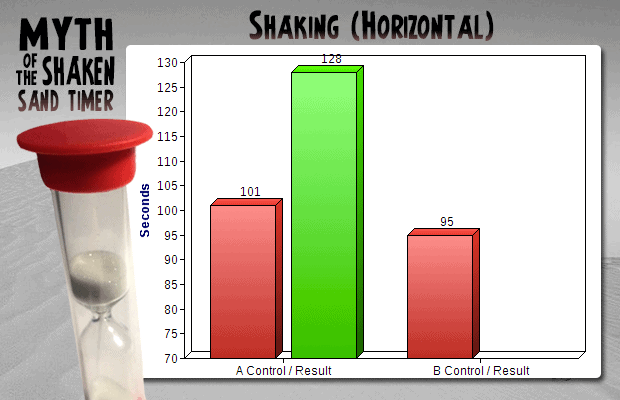
A 2:08 (128 seconds) / +27 seconds
B I don’t think another is necessary…
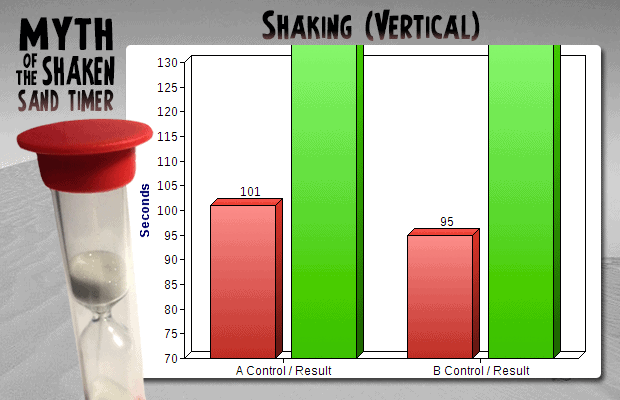
A OH MY GOSH it’s been three minutes and there’s still so much sand in the top!
B No chance.
That was miserable.
I’m still intrigued, though, by that one bottom-flicking (okay that just sounds strange) run, where the timer ran fast. If I could exaggerate that method…
Commencing bottom-compartment contact with electric vibrating therapeutic foot massage device in
3…2…1…

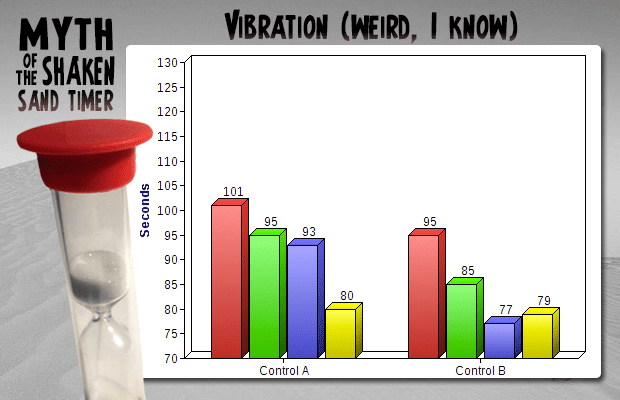
A 1:35 (95 seconds) / -6 seconds
B 1:25 (85 seconds) / -10 seconds
A 1:33 (93 seconds) / -8 seconds
B 1:17 (77 seconds) / -18 seconds
A 1:20 (80 seconds) / -21 seconds
B 1:19 (79 seconds) / -16 seconds
Amazing! Would this method work for speeding up sand timers in the games that are actually in my closet? Only one way to find out.
Quelf: Control: 30 seconds / Vibration: 18 seconds / -12 seconds
Wits and Wagers: Control: 30 seconds / Vibration: 30 seconds / +0 seconds
Perquackey: Control: 225 seconds / Vibration: 212 seconds / -13 seconds
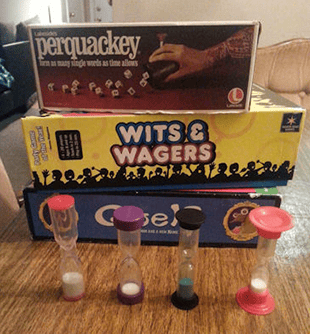
Okay, first observation is that, apparently, very few games come with sand timers nowadays…
Second, I need me one of those paisley silk shirts from the seventies.
But thirdly, that’s interesting… each game was affected by this method except for Wits and Wagers. Above is a picture of the four timers used in this experiment. Notice that the W&W timer differs from the others in that the hourglass itself is encased in a plastic cylinder. Perhaps the difference in the design reduces the vibration effect on the sand. I suppose that’s a study for another day…

So, in conclusion, extremely high-speed shaking has an effect on some sand timers to reduce the time elapsed. But why?
Perhaps that’s where I pass the baton of semi-scientific methodology over to you, curious one. For now, be content knowing that when looking down the barrel of defeat in a cutthroat game of Pictionary, victory can be yours with the mere introduction of an electronic vibrating massage wand. Ah… science….



